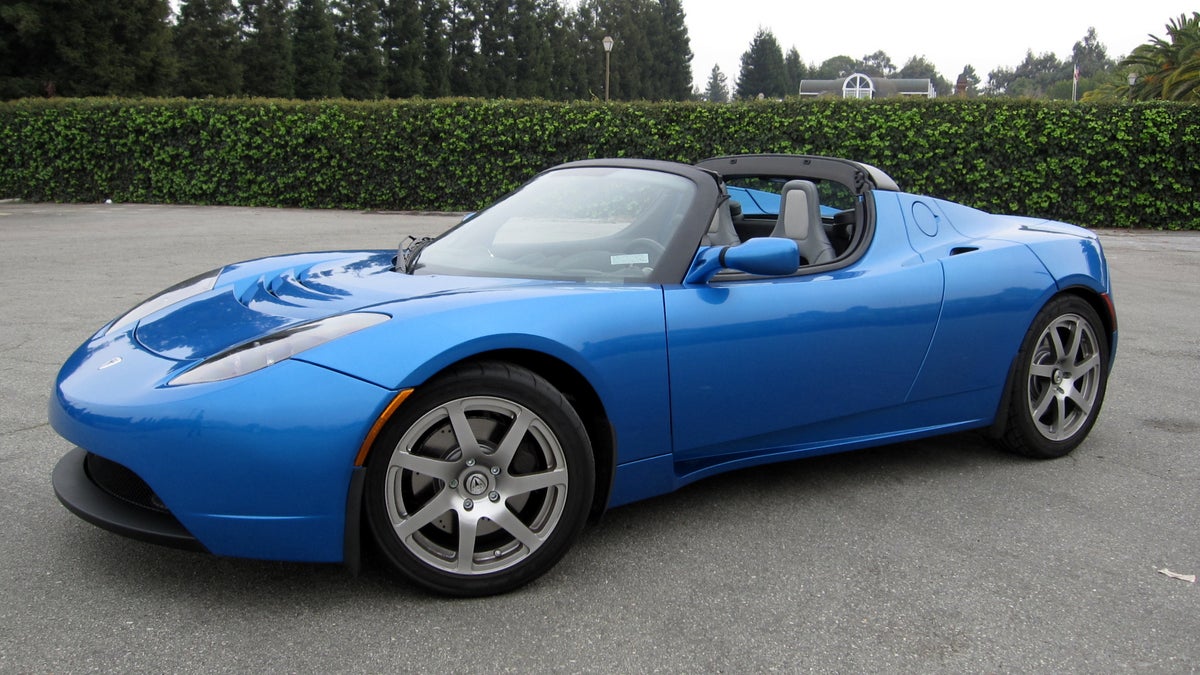Tesla 1.5 test drive
CNET Car Tech gets some seat time in the Tesla roadster fitted with the version 1.5 powertrain.

Every automotive journalist who drives a Tesla comes away impressed with the car's power, and I can say the same after taking the car out on a quick drive near the company's Menlo Park, Calif., Tesla store (they don't call it a showroom or dealership).
In Performance mode, the car exhibits powerful and smooth torque, even at speed. I had this little open top roadster at 65 mph on the freeway, then mashed the accelerator (don't call it a gas pedal) and got another powerful push in the back that sent the car quickly up to 90. The Tesla's push is unique among sports cars though. Where a high-stepper such as the BMW M3 makes you feel a kick in the back with every gear shift, the Tesla delivers a strong, steady push when you put your foot down on the pedal.
The Tesla I drove featured "Powertrain 1.5," eliminating the two-speed gearbox from the previous model. Yes, Tesla patterns itself after tech companies, so the power train gets a version designation, although the cars themselves still go by a model year.
In this Tesla, as in other electric cars I've driven, the operation is dead simple: Move the shifter from Neutral to Drive, and you're moving forward. Push the accelerator if you want to go faster and hit the brakes if you want to stop. The only real difference, besides the fact that the Tesla goes a lot faster than other electric cars, is that taking your foot off the accelerator at speeds less than 40 mph makes the car slow down as if you were applying light pressure on the brakes. That is the regenerative power train in operation, using the car's momentum to generate electricity for the battery pack. The Tesla also has regenerative brakes, but you don't need to use them much, adding the side-benefit of very infrequent brake maintenance.
After building up some speed on the freeway while testing the car's acceleration, I took pressure off the accelerator, and the car didn't dramatically slow down, as it would have at slower speeds, instead coasting along as you would expect from any car. That shows some really smart behavior. As for the car's handling, well, you can thank Lotus for its precise steering and excellent road-holding capabilities.
Lotus builds the chassis for these cars, and then ships them to Tesla's plant, where the power train is added. A colleague pointed out a couple of performance issues that I noticed as well. One, the actual brakes feel a little light, like they wouldn't provide the kind of slowing power you want on a track. And two, the suspension feels softer than you would get on a Lotus Elise, as if Tesla specified a more comfortable ride for the car's well-heeled market.
The Tesla is 700 pounds heavier than a Lotus Elise, and you feel that weight while cornering. All of that extra weight comes from the 990-pound lithium ion battery that sits behind the passenger compartment. Tesla strips out extra weight elsewhere around the car, though, most notably in having the body panels made from carbon fiber, as opposed to the fiberglass panels on a Lotus.
Although the Tesla's $109,000 price tag may seem high, it's the cheapest car you can get with an all-carbon fiber body. Tesla also brags that it's a lot cheaper than a Ferrari, but with similar performance. Well, a Chevy Corvette or Nissan GT-R is substantially cheaper than the Tesla. However, where you will come out ahead in a Tesla is maintenance and running costs. Charging it up overnight costs pennies, compared with the ever-fluctuating prices for a tank-full in a gas-powered car, and there are fewer moving parts in the Tesla.
The electric motor, about the size of a watermelon, doesn't have injectors, camshafts, pistons, or gaskets, some of many things that can go bad on a gas engine. The day I was at the Tesla store, a few cars were in for maintenance, but in a Tesla, all that meant was a firmware update.
One of the most fascinating things about the car is that as battery technology improves, the entire battery pack could be replaced more easily than you could replace the engine in a car. And new battery technology is likely to be lighter and have greater power density. That means substantially changed performance characteristics for the car, such as more range, better acceleration, and a higher top speed.
The car I drove was in Performance mode. The car has a few other modes, selectable on a little touch screen inconveniently placed down by the driver's left knee, such as Standard and Range. Being an electric car, the Tesla's driving range will fluctuate drastically depending on driving style. These different modes set potential energy-wasting characteristics such as acceleration and speed, so a car in Range mode won't offer near the amount of excitement as the Performance mode, but will reach its EPA rated range of 227 miles or better. I can see why the Tesla representatives insist on putting the car into Performance mode for journalist drives. We're only impressed by a car that responds well to a lead foot.
Click here for our photos of the Tesla store, factory, and the Tesla electric sports car.

